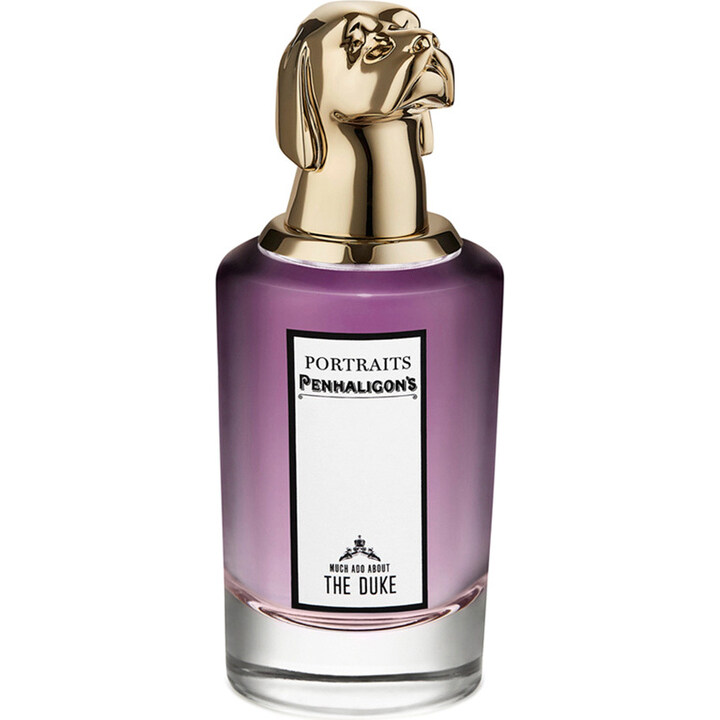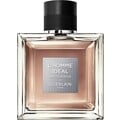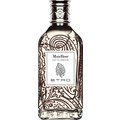Portraits - Much Ado About the Duke Penhaligon's 2016
24
Top Review
Translated
Show original
A dozen roses for the man (8/12)
As a newcomer here, I'm going to try my hand at a series of comments. This is the eighth part.
The motivation, the idea and the criteria
I'm a real fan of the scent of roses (in my youth my mother had Paris from YSL. I found "the hammer") but the rose is not exactly the first thing you come across as part of a men's fragrance. Nevertheless the rose is included in - as I think - more and more men's fragrances.
According to the following criteria I have therefore selected 12 of these fragrances and will comment and compare them bit by bit:
- Men's fragrance (except Desert Rose by Urban Scent as a unisex scent, I just had to use it)
- Rose as heart note (exception: Much Ado About The Duke from Penhaligon's, I was just in London at the time of the idea)
- Published from the year 2000
- Rating of at least 6.0 with at least 40 ratings
- No oud (not mine)
Fragrance number 8 is: Much Ado About The Duke (*2016) by Penhaligon's
(previously: (1) Lumière Noire pour Homme from Maison Francis Kurkdjian, (2) 24 Old Bond Street Triple Extract from Atkinsons, (3) Lyric Man from Amouage, (4) Colonia Ambra from Acqua di Parma), (5) Déclaration d'un Soir from Cartier, (6) Desert Rose from Urban Scents , (7) ManRose from Etro)
The house, the perfumer and shopping
From a "corner BarberShop""" to a worldwide perfume empire. William Henry Penhaligon (1837-1902) was a barber and founded his business in 1861 in Penzance (county of Cornwall in England). In 1869 he moved to London and worked in a hammam in Jermyn Street, also as a barber. Jermyn Street in central London was famous for the shirt makers who lived there and the very exclusive hammam was visited by politicians, celebrities and members of the royal family. In 1872 William Penhaligon also released his first fragrance, it was "Hammam Bouquet". Inspired by the aromas of the Turkish bath, it is said to have been William Penhaligon's favourite throughout his life and is still one of Penhaligon's bestsellers today. In 1880 he founded the company Penhaligon's & Jeavons (Haircutters and Perfumers), since then Penhaligon's has been awarded several times as purveyor to the court of the English Royal House, most recently in 1988 by Lady Diana Princess of Wales. In 2015 the Spanish company Puig took over Penhaligon's. The company, which is still family-owned (now in its third generation), was founded in 1914 and, in addition to Penhaligon's, also distributes Paco Rabanne, Jean Paul Gaultier, Comme des Garçons, Prada and L'Artisan Parfumeur, among others. In 2016, Puig launched Penhaligon's, an entire collection of new fragrances - as "olifactory fiction". The fiction consists of a rather eccentric British aristocratic family. Each fragrance is accompanied by a short story to introduce us to the person behind the fragrance (there is even a small booklet "Penhaligon's Portraits - Into the wild"). One of the fragrances is "Much Ado About The Duke". And the list of Swiss perfumer Daphné Bugey, who created the fragrance, is as illustrious as the Puig brands. From "Armani Privé - Rose Milano" (brand new!) to "Rose 31" (from Le Labo) to Valentino's "Valentina Pink", the rose also plays a major role in her work. I had to buy "the Duke" in one of the small Penhaligan's boutiques - great!
The fragrance, the ingredients and the experience
But once again back to the aristocratic family. The Duke Nelson has married London's most desirable girl, the Duchess Rose. However, his whimsical impulses make the tongues of society boil. The rumor is that his still young marriage is already at an end. The fragrance is accordingly ambivalent like him: a floral yet masculine, leathery-woody scent. The scent starts peppery, almost a bit "sprittig". Nevertheless very pleasant, but of course striking and angular. The distinct gin note reminds of "Juniper Sling" from the same house. But here the whole thing becomes softer very quickly, due to a wonderful, almost lovely rose. The latter only underpins and never takes a dominant role. Soon the woody note is added. Whereby I don't think it is cashmere wood (as one of my pre-commentators thinks) but a mixture of cedar and especially sandalwood and I think I can make out leather as well. The rose always remains in a discreet centre. And if ever there was a flower that symbolizes perfume, it would certainly be the rose. It has already played a role in all kinds of cultures. The ancient Egyptians considered the rose sacred to the goddess Isis, in the classical world the rose is associated with the goddess of love (Aphrodite or Venus) and in medieval Christianity the five petals of the flower symbolize the five wounds of Christ and are later associated with the Virgin Mary. Already towards the end of the Middle Ages the rose was cultivated for its fragrance in the Middle East.
The conclusion, the comparison and the practical application
Spicy and woody (like "Colonia Ambra", see "A Dozen Roses for Men - 4/12") with a subtle floral - i.e. rosy - quality makes "Much Ado About The Duke" an ambivalent classic. He combines the femininity of the rose with the masculinity of sandalwood and leather. The whole thing perfectly connected and balanced, chic and perhaps a little decadent, strong and invigorating as well as soft and supple. With good 100 ratings so far a 8.1, from me there is a smooth 10!
(1) Lumière Noire pour Homme - The noble softie
(2) 24 Old Bond Street Triple Extract - The Elegant Briton
(3) Lyric Man - The "pure" rose
(4) Colonia Ambra - The "warm (rose) wood"
(5) Déclaration d'un Soir - The "olfactory emotion"
(6) Desert Rose - "The Name of the Rose"
(7) ManRose - The aesthete
(8) Much Ado About The Duke
The motivation, the idea and the criteria
I'm a real fan of the scent of roses (in my youth my mother had Paris from YSL. I found "the hammer") but the rose is not exactly the first thing you come across as part of a men's fragrance. Nevertheless the rose is included in - as I think - more and more men's fragrances.
According to the following criteria I have therefore selected 12 of these fragrances and will comment and compare them bit by bit:
- Men's fragrance (except Desert Rose by Urban Scent as a unisex scent, I just had to use it)
- Rose as heart note (exception: Much Ado About The Duke from Penhaligon's, I was just in London at the time of the idea)
- Published from the year 2000
- Rating of at least 6.0 with at least 40 ratings
- No oud (not mine)
Fragrance number 8 is: Much Ado About The Duke (*2016) by Penhaligon's
(previously: (1) Lumière Noire pour Homme from Maison Francis Kurkdjian, (2) 24 Old Bond Street Triple Extract from Atkinsons, (3) Lyric Man from Amouage, (4) Colonia Ambra from Acqua di Parma), (5) Déclaration d'un Soir from Cartier, (6) Desert Rose from Urban Scents , (7) ManRose from Etro)
The house, the perfumer and shopping
From a "corner BarberShop""" to a worldwide perfume empire. William Henry Penhaligon (1837-1902) was a barber and founded his business in 1861 in Penzance (county of Cornwall in England). In 1869 he moved to London and worked in a hammam in Jermyn Street, also as a barber. Jermyn Street in central London was famous for the shirt makers who lived there and the very exclusive hammam was visited by politicians, celebrities and members of the royal family. In 1872 William Penhaligon also released his first fragrance, it was "Hammam Bouquet". Inspired by the aromas of the Turkish bath, it is said to have been William Penhaligon's favourite throughout his life and is still one of Penhaligon's bestsellers today. In 1880 he founded the company Penhaligon's & Jeavons (Haircutters and Perfumers), since then Penhaligon's has been awarded several times as purveyor to the court of the English Royal House, most recently in 1988 by Lady Diana Princess of Wales. In 2015 the Spanish company Puig took over Penhaligon's. The company, which is still family-owned (now in its third generation), was founded in 1914 and, in addition to Penhaligon's, also distributes Paco Rabanne, Jean Paul Gaultier, Comme des Garçons, Prada and L'Artisan Parfumeur, among others. In 2016, Puig launched Penhaligon's, an entire collection of new fragrances - as "olifactory fiction". The fiction consists of a rather eccentric British aristocratic family. Each fragrance is accompanied by a short story to introduce us to the person behind the fragrance (there is even a small booklet "Penhaligon's Portraits - Into the wild"). One of the fragrances is "Much Ado About The Duke". And the list of Swiss perfumer Daphné Bugey, who created the fragrance, is as illustrious as the Puig brands. From "Armani Privé - Rose Milano" (brand new!) to "Rose 31" (from Le Labo) to Valentino's "Valentina Pink", the rose also plays a major role in her work. I had to buy "the Duke" in one of the small Penhaligan's boutiques - great!
The fragrance, the ingredients and the experience
But once again back to the aristocratic family. The Duke Nelson has married London's most desirable girl, the Duchess Rose. However, his whimsical impulses make the tongues of society boil. The rumor is that his still young marriage is already at an end. The fragrance is accordingly ambivalent like him: a floral yet masculine, leathery-woody scent. The scent starts peppery, almost a bit "sprittig". Nevertheless very pleasant, but of course striking and angular. The distinct gin note reminds of "Juniper Sling" from the same house. But here the whole thing becomes softer very quickly, due to a wonderful, almost lovely rose. The latter only underpins and never takes a dominant role. Soon the woody note is added. Whereby I don't think it is cashmere wood (as one of my pre-commentators thinks) but a mixture of cedar and especially sandalwood and I think I can make out leather as well. The rose always remains in a discreet centre. And if ever there was a flower that symbolizes perfume, it would certainly be the rose. It has already played a role in all kinds of cultures. The ancient Egyptians considered the rose sacred to the goddess Isis, in the classical world the rose is associated with the goddess of love (Aphrodite or Venus) and in medieval Christianity the five petals of the flower symbolize the five wounds of Christ and are later associated with the Virgin Mary. Already towards the end of the Middle Ages the rose was cultivated for its fragrance in the Middle East.
The conclusion, the comparison and the practical application
Spicy and woody (like "Colonia Ambra", see "A Dozen Roses for Men - 4/12") with a subtle floral - i.e. rosy - quality makes "Much Ado About The Duke" an ambivalent classic. He combines the femininity of the rose with the masculinity of sandalwood and leather. The whole thing perfectly connected and balanced, chic and perhaps a little decadent, strong and invigorating as well as soft and supple. With good 100 ratings so far a 8.1, from me there is a smooth 10!
(1) Lumière Noire pour Homme - The noble softie
(2) 24 Old Bond Street Triple Extract - The Elegant Briton
(3) Lyric Man - The "pure" rose
(4) Colonia Ambra - The "warm (rose) wood"
(5) Déclaration d'un Soir - The "olfactory emotion"
(6) Desert Rose - "The Name of the Rose"
(7) ManRose - The aesthete
(8) Much Ado About The Duke
12 Comments
Latest Reviews
 Micscent 4 years ago
Micscent 4 years ago
A dozen roses for the man (9/12)
As a newbie (meanwhile not so new anymore), I try to write a series of comments. This is the ninth part.
The motivation, the idea and the criteria
I'm a real fan of the scent of roses (in my youth my mother had Paris from YSL. I thought...
Translated




